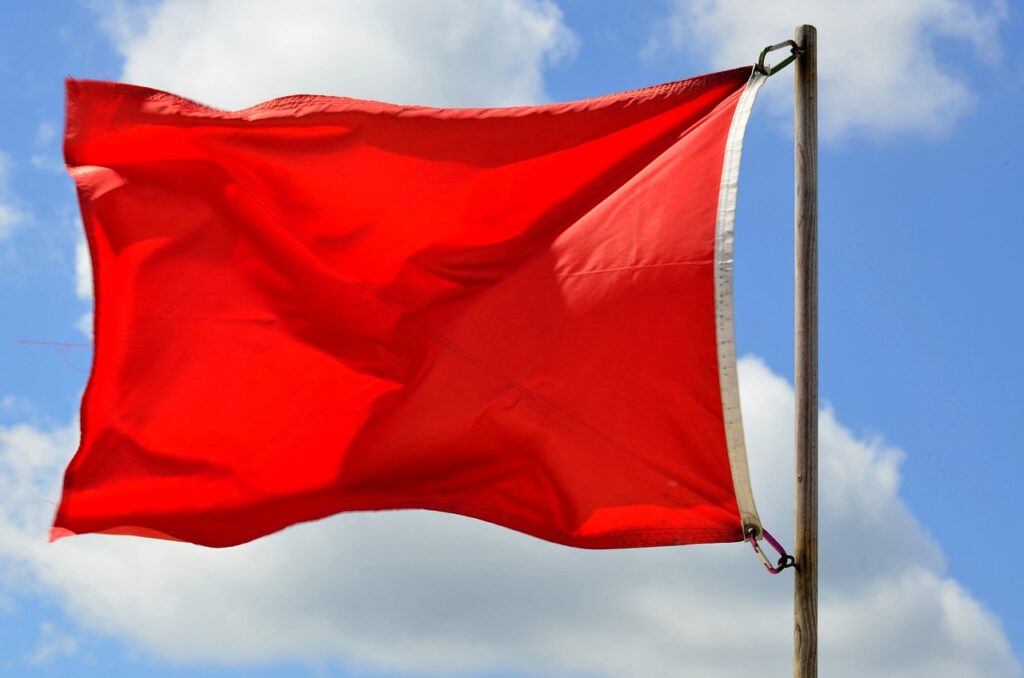Recently (in April 2024) Red Pine Exploration issued several press releases highlighting that some assays in their geological database were found to have been manipulated. Numerous assays input into their database did not match the original lab certificates. Is this another mining scam?
The Red Pine event led me to ask some colleagues about similar situations that have occurred and whether the personnel responsible were ever sanctioned. Their feedback provided me with several past examples of such incidents, which I have attempted to summarize in this two-part blog post. Big thanks to my colleagues that took the time to provide these examples.
Raise the Red Flag
 The focus of this blog is on the types of activities that raised the red flags in the past. I am less interested in naming the people responsible, although the associated web links do provide more detail on the events.
The focus of this blog is on the types of activities that raised the red flags in the past. I am less interested in naming the people responsible, although the associated web links do provide more detail on the events.
Not all of the examples listed in these two blogs are scams or deliberate falsification of results. Some may be incompetence, faulty reporting, or lack of diligence and care. Some of these involve company executives, in-house Qualified Persons (QPs), and independent QP’s working for the companies.
Part 1 has examples mainly involving company management or in-house QPs. Part 2 will provide other examples where QP’s have been held to account for their poor quality of their work.
Examples (Part 1)
The following are presented in no particular order. Some of these may still be at the allegation or investigation stage. This blog post can be updated when the issue is eventually resolved.
Tampering with Samples: Bre-X salting of samples is the number one example of a well orchestrated scam. I’m not sure if anyone was ever officially convicted of anything at Bre-X, but it warranted several books, recent podcasts, and even a loosely-based Hollywood movie (Gold). As an aside, I had spoken with the Bre-X team in 1995 about consulting work while I was living in Calgary. However, they were still far from needing mine engineering services at that time. That would have been a wild ride, although with my luck, I would have ended up being the only one in jail. For further information here is an interesting story from Warren Irwin on the Bre-x story. https://redcloudfs.com/25-years-after-bre-x-by-the-man-who-made-a-fortune-going-long-short-of-the-biggest-ever-mining-fraud/
Falsifying QP Signature: The B.C. Securities Commission (BCSC) is alleging that a B.C.-based mining company and its CEO made false or misleading statements about an Idaho mineral deposit in a report that it filed. In 2019, Multi-Metal filed a technical report which contained an electronic signature of a qualified person – a professional engineer – and listed him as an author. The BCSC alleges the qualified person did not review, sign, or consent to filing Multi-Metal’s report. At this time, the BCSC’s allegations have not yet been proven.
Link 1
Falsifying Assay Data: The Ontario Securities Commission approved a settlement agreement between a geologist with 30 years of experience and the Qualified Person for Bear Lake Gold Ltd. Between 2007 and 2009 the QP altered certain assay results and transferred these results into the company’s assay database; prepared draft press releases that contained incorrect and inflated data, then provided Independent QP’s with the altered data, and also replaced core and modified a drill core log. In the settlement, the QP agreed to a permanent ban from acting as a Director and Officer of any issuer, an administrative penalty of $750,000, $50,000 in costs, and a prohibition from trading.
Link 1
Link 2
Link 3
Falsifying Assay Data: In 2024 Red Pine Exploration Inc. reported that there were 382 assay inconsistencies out of a total of 60,000 assay results for the 2019-2024 Period, representing 95 intersections contained within 69 drill holes as follows. An independent investigation is underway, however at the time of this blog, the investigation is still on-going. A link will be provided here once their final report is disclosed publicly.
Link 1
Tampering with Samples: This example goes back to 1981, involving New Cinch Uranium. They published test results that showed significant gold and silver at their New Mexico property. After the stock jumped, third party tests showed that samples did not contain any significant amount of precious metals. The New Cinch samples were “salted”. The Vancouver Stock Exchange was sued for not verifying the company’s test results. In response, the VSE made it compulsory for companies to issue a disclaimer on each press release stating that the VSE “neither approves nor disapproves of their contents”. This case goes back 40 years, so limited information is available on it. A bit more discussion on this case and discussing the VSE is found at the link below. While the VSE no longer exists, the TSX has taken over.
Link 1
Falsifying Assay Data: This example involves Southwestern Resources, a company with the Boka Project in China. The former CEO and President, John Paterson, was the company’s QP. In 2007, a month after Paterson’s resignation, Southwestern announced there were errors in previously reported assay results. As a result, Southwestern withdrew all of its previously disclosed results for that project. Sounds familiar? An independent investigation by Snowden led to a revised resource estimate that was substantially less than previously reported and identified 433 discrepancies in gold grades reported in dozens of 2003 and 2007. The original assay certificates were sent to Paterson and he was the sole recipient. Instead of transferring the true assay certificate data, Paterson transferred data containing discrepancies into the database. There was 6 years of jail time involved with this case.
Link 1
Link 2
Link 3
Link 4
Falsified Resource Estimate: This one goes back to 1997, although sanctioning of parties was only done in 2007. The company geologist was accused of several things, including not having adequate data to support the findings in his 1997 resource report; the methods used to calculate resources were not appropriate; the report portrayed the project as more advanced than it was; the $129 projected share value was based on “unsubstantiated tonnage and grade information and data.”. Exotic assaying methods and duping accredited investors was also part of this operation.
Link 1
Using Exploration Targets in Economic Analysis: This event goes back to 2012 and involves a company breaking the rules by disclosing the results of an economic analysis that included a target for further exploration (pie-in-the-sky) of the company’s gold mining operation. The economic analysis was not based on a current resource estimate. The punishment was the proponents had to pay to the commission $20,000 and complete a course of study on the requirements of Canadian mining rules.
Link 1
Conclusion
 This ends Part 1 of this blog post. Part 2 will continue with a few more examples, specifically involving Qualified Persons, and can be found at this link Junior Mining Shams and Scams – Part 2
This ends Part 1 of this blog post. Part 2 will continue with a few more examples, specifically involving Qualified Persons, and can be found at this link Junior Mining Shams and Scams – Part 2
Discipline is typically rendered in two ways; the Security Commission may prosecute; or the professional associations will provide sanctions. Typically, the professional association penalties are more lenient, consisting of a temporary license suspension and the payment of legal fees.
If readers have any other examples of such junior mining stories, email them to me at kjkltd@rogers.com and I can add them to this blog.

